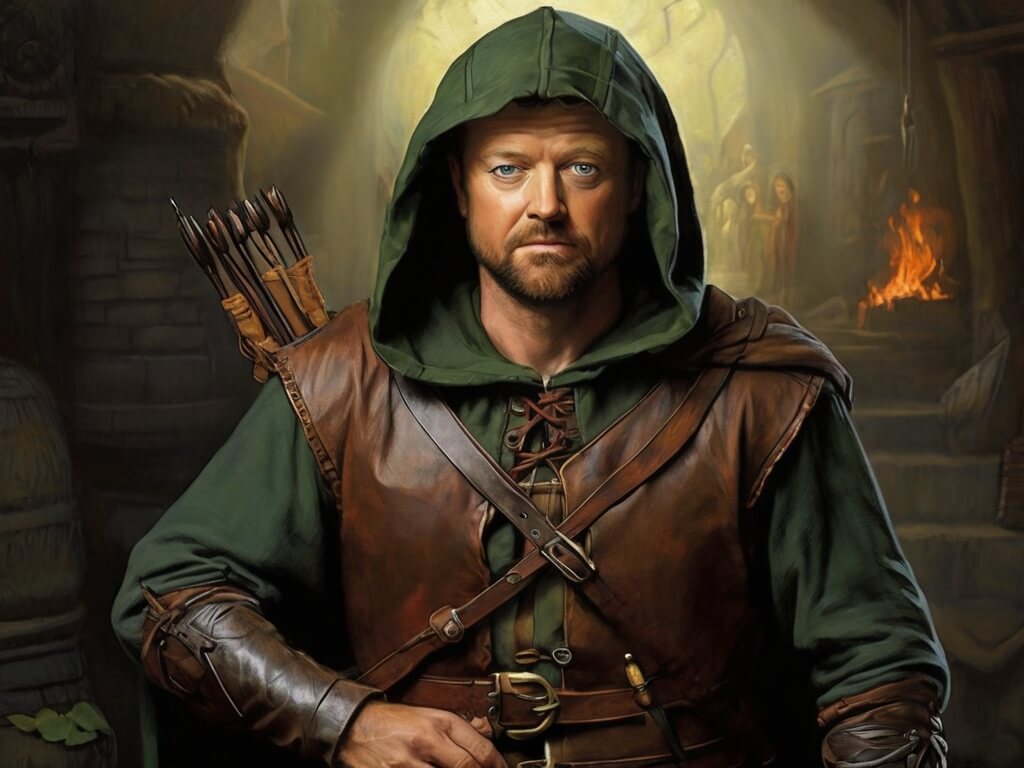Dive into the captivating tale of Robin Hood, the legendary outlaw of medieval England. Explore the origins of the character, the earliest ballads, and the iconic Sherwood Forest setting. Discover Robin’s chivalrous deeds, humorous exploits, and his band of notable companions. Uncover the evolution of the Robin Hood tradition, from Maid Marian to Friar Tuck, and its enduring place in popular imagination.

Robin Hood; a legendary outlaw of medieval England. It is not known whether a historical character of this name forms a basis for the many tales which have collected about him. The first datable reference to him is the Yorkshire place name, The Stone of Robin Hood, cited in a document of 1322. He is also mentioned later in the 14th century ; 15th century references to him are more numerous; and 16th century ones are very frequent.
The 38 ballads which are the earliest and most important repositories of tales about him cannot be dated precisely. They range from the 14th or early 15th century onward. In most of them his activities are localized in the forest of Sherwood, in Nottinghamshire, or in that of Barnsdale, in Yorkshire. He leads an outlaw band, of whom Little John, Will Scathlok (Scadlok, or Scarlet), and Much are the most notable members. He is said to take money from the rich and give it to the poor, although he is ready to aid an innocent and afflicted member of any class. His enemies are the propertied and entrenched individuals who defend injustice and make money from it, in particular the sheriff of Nottingham and the abbots of rich monasteries. To the king, however, he is loyal, although he and his band steal the king’s deer ; and his veneration of the Virgin Mary is such that he will protect all women for her sake. He loves the free life of the forest, fights well with the quarterstaff, and excels all with the longbow. He is manly, rough-and-ready, chivalrous, trustful, fair, and humorous, even at his own expense.
In all these qualities he reflects the feelings and aspirations of the English yeoman class, for whom minstrels probably first sang these ballads. In A Gest of Robin Hood, the longest and most important of these, he lends, on no other security than the Virgin, a large sum to an impoverished knight who is in debt to an avaricious abbot. After having taken twice this sum from a monk of the abbot’s monastery, he refuses the knight’s proferred repayment on the grounds that the Virgin has already miraculously discharged the debt. Later, the king (Edward IV) comes disguised as an abbot to capture the outlaw, and is taken by Robin himself. Face to face, the two recognize their common manliness, fairness, and humor ; and the king, dressed in the green of the outlaw band, enjoys the joke of frightening the townspeople of Nottingham. Robin is finally killed by treacherous agents whom he had trusted.
In Robin Hood and the Potter, as in many other ballads, the tables are turned on him when a representative of the lower classes unexpectedly beats him at the quarterstaff. Good-humoredly, Robin borrows the potter’s clothes and wares and daringly plays a humorous trick on the sheriff of Nottingham. In Robin Hood and Allen a Dale he again disguises himself to prevent the marriage of an old, rich knight to a girl who is in love with Allen. Little John, dressed in a priest’s habit, marries the lovers on the spot.

Among later additions to the Robin Hood tradition is Maid Marian, his beloved, who may have appeared in morris dances or plays connected with May Day festivals in the late 15th century. In the play The Death of Robert, Earl of Huntington (1601), probably by Anthony Munday, there is the first known instance of the tradition that he was of noble origin. His follower Friar Tuck is also a late arrival’ to the tradition.
The character of Robin Hood still holds a firm place in popular imagination. Since the beginning of the 16th century, fictional treatments of him and his followers have accumulated : at least 60 separate versions in prose, 30 plays, 7 operas, and a number of motion pictures are known to exist. He is a character in such widely different novels as Ivanhoe (1820), by Sir Walter Scott, and The Once and Future King (1958) by Terence H. White. As with many legendary heroes, Robin Hood has been placed in various times in different versions. Where any reigning ruler is named in the medieval ballads, it is generally Edward IV (r. 1461-1483), though the earliest ballads were written before that time. Scott and others have identified Robin Hood with the time and the person of Richard I (r. 1189-1199), thus merging the legend of the outlaw with that of the king.